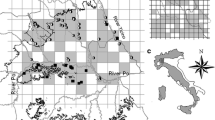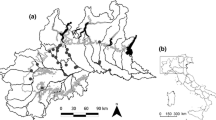Abstract
The closely related mustelids European pine marten (Martes martes) and stone marten (Martes foina) sympatrically inhabit a large area of Europe. However, given our limited knowledge of their bioecological relationships, their extremely elusive behaviour and the fact that their faeces cannot be distinguished on the basis of morphology alone, it is very difficult to monitor their populations. In this study, we describe a reliable non-invasive polymerase chain reaction (PCR)–restriction fragment length polymorphism (PCR-RFLP) method for distinguishing between M. martes and M. foina based on the analysis of deoxyribonucleic acid extracted from faeces samples. The method was specifically designed to avoid possible interference from potential prey mammals and other sympatric carnivores. The procedure consists of PCR amplifying a mitochondrial D-loop region followed by digesting the resulting 276-bp-long amplicons with the restriction enzymes HaeIII and RsaI. To assess the efficiency of this technique, we conducted a preliminary field study across the potential sympatric distribution areas of both marten species in the northern Iberian Peninsula. Out of 359 faeces samples collected, we identified 80 as specimens from the stone marten and 235 from the pine marten. Unequivocal species identification was thus possible in 88% of the faeces samples collected. These findings reveal the combined use of non-invasive genetic sampling and GIS technology to be a reliable and cost-effective procedure for improving our knowledge of the spatial distributions of sympatric marten species. This protocol could also be used to identify and improve information gaps, to develop effective research and management programmes and in population and landscape genetics studies of marten species.



Similar content being viewed by others
References
Bikandi J, San Millán R, Rementeria A, Garaizar J (2004) In silico. analysis of complete bacterial genomes: PCR, AFLP-PCR, and endonuclease restriction. Bioinformatics 20:798–799
Birks JDS, Messenger JE, Braithwaite TC, Davison A, Brookes RC, Strachan C (2004) Are scat surveys a reliable method for assessing distribution and population status of pine martens? In: Harrison DJ, Fuller AK, Proulx G (eds) Martens and fishers (Martes) in human-altered environments: an international perspective. Springer, New York, pp 235–252
Broquet T, Ménard N, Petit E (2006) Noninvasive population genetics: a review of sample source, diet, fragment length and microsatellite motif effects on amplification success and genotyping error rates. Conserv Genet 8:249–260
Broquet T, Petit E (2004) Quantifying genotyping errors in noninvasive population genetics. Mol Ecol 13:3601–3608
Colli L, Cannas R, Deiana AM, Gandolfi G, Tagliavini J (2005) Identification of mustelids (Carnivora: Mustelidae) by mitochondrial DNA markers. Mamm Biol 6:384–389
Dalén L, Götherström A, Angerbjörn A (2004) Identifying species from pieces of faeces. Conserv Genet 5:1–3
Davison A, Birks JDS, Brookes RC, Braithwaite TC, Messenger JE (2002) On the origin of faeces: morphological versus molecular methods for surveying rare carnivores from their scats. J Zool (Lond) 257:141–143
Davison A, Birks JDS, Brookes RC, Messenger JE, Griffiths HI (2001) Mitochondrial phylogeography and population history of pine martens Martes martes compared with polecats Mustela putorius. Mol Ecol 10:2341–2347
Davison A, Birks JDS, Griffiths HI, Kitchener AC, Bigginns D, Butlin RK (1999) Hybridization and the phylogenetic relationships between polecats and domestic ferrets in Britain. Biol Conserv 87:155–161
Delibes M (1983) Interspecific competition and the habitat of the stone marten Martes foina (Erxleben, 1777) in Europe. Acta Zool Fenn 174:229–231
Domingo-Roura X (2002) Genetic distinction of marten species by fixation of a microsatellite region. J Mammal 83:907–912
Frankham R, Ballou JD, Briscoe DA (2002) Introduction to conservation genetics. Cambridge University Press, Cambridge, UK
Gómez-Moliner BJ, Cabria MT, Rubines J, Garin I, Madeira MJ, Elajalde A, Aihartza J, Fournier P, Palazón S (2004) PCR-RFLP identification of mustelid species: European mink (Mustela lutereola), American mink (Mustela vison) and polecat (Mustela putorius) by analysis of excremental DNA. J Zool (Lond) 262:311–316
Grakov NN (1994) Kidus-a hybrid of the sable and the pine marten. Lutreola 1:1–4
Hansen MM, Jacobsen L (1999) Identification of mustelid species: otter (Lutra lutra), American mink (Mustela vison) and polecat (Mustela putorius), by analysis of DNA from faecal samples. J Zool (Lond) 247:177–181
Helldin JO (1998) Pine marten (Martes martes) population limitation. Dissertation, Swedish University, Agricultural Sciences, Uppsala, Sweeden
Höss M, Kohn M, Pääbo S, Knauer F, Scgroder W (1992) Excremental analysis by PCR. Nature 359:199
Kalz B, Jewgenow K, Fickel J (2006) Structure of an otter (Lutra lutra) population in Germany—results of DNA and hormone analyses from faecal samples. Mamm Biol 71:321–335
Kocher TD, Thomas WK, Meyer A, Edwards SV, Pääbo S, Villablanca FX, Wilson AC (1989) Dynamics of mitochondrial DNA evolution in animals: amplification and sequencing with conserved primers. Proc Natl Acad Sci USA 86:6196–6200
Kohn MH, Wayne RK (1997) Facts from feces revisited. TREE 12:223–227
Lynch ÁB, Brown MJF, Rochford JM (2006) Fur snagging as a method of evaluating the presence and abundance of a small carnivore, the pine marten (Martes martes). J Zool (Lond) 270:330–339
Marchesi P, Lachat N, Lienhard R, Debieve PH, Mermod C (1989) Comparaison des régimes alimentaires de la fuine (Martes foina Erxl) et de la martre (Martes martes L) dans une région du Jura suisse. Rev Suisse Zool 96:127–146
Messenger JE, Birks JDS (2000) Monitoring the very rare pine marten populations in England and Wales. In: Griffiths HI (ed) Mustelids in a modern world: management and conservation aspects of small carnivore: human interactions. Backhuys, Leiden, pp 153–162
Miller CR, Joyce P, Waits LP (2002) Asessing allelic dropout and genotype reliability using maximum likelihood. Genetics 160:357–366
Mowat G, Paetkau D (2002) Estimating marten Martes americana population size using hair capture and genetic tagging. Wildl Biol 8:201–209
Murakami T (2002) Species identification of mustelids by comparing partial sequences on mitochondrial DNA from fecal samples. J Vet Med Sci 64:321–323
Piggott MP, Taylor AC (2003) Remote collection of animal DNA and its applications in conservation management and understanding the population biology of rare and cryptic species. Wildl Res 30:1–13
Pilot M, Gralak B, Goszczyński J, Posłuszny M (2006) A method of genetic identification of pine marten (Martes martes) and stone marten (Martes foina) and its application to faecal samples. J Zool (Lond) 271:140–147
Proulx G, Aubry KB, Birks J, Buskirk SW, Fortin C, Frost HC, Krohn WB, Mayo L, Monakhov V, Payer D, Saeki M, Santos-Reis M, Weir R, Zielinski WJ (2004) World distribution and status of the genus Martes in 2000. In: Harrison DJ, Fuller AK, Proulx G (eds) Martens and fishers (Martes) in human-altered environments: an international perspective. Springer, New York, pp 21–76
Randi E, Lucchini V (2002) Detecting rare introgression of domestic dog genes into wild wolf (Canis lupus) populations by Bayesian admixture analyses of microsatellite variation. Conserv Genet 3:31–45
Riddle AE, Pilgrim KL, Mills LS, McKelvey KS, Ruggiero LF (2003) Identification of mustelids using mitochondrial DNA and non-invasive sampling. Conserv Genet 4:241–243
Russell AJM, Storch I (2004) Summer food of sympatric red fox and pine marten in the German Alps. Eur J Wildl Res 50:53–58
Schwartz MK, Tallmon DA, Luikart G (1998) Review of DNA based census and effective population size estimators. Anim Conserv 1:293–299
Taberlet P, Griffin S, Goossens B, Questiau S, Manceau V, Escaravage N, Waits LP, Bouvet J (1996) Reliable genotyping of samples with very low DNA quantities using PCR. Nucleic Acids Res 24:3189–3194
Taberlet P, Waits LP, Luikart G (1999) Noninvasive genetic sampling: look before you leap. TREE 14:323–327
Tamura K (2000) On the estimation of the rate of nucleotide substitution for the control region of human mitochondrial DNA. Gene 259:189–197
Thompson JD, Gibson TJ, Plewniak F, Jeanmougin F, Higgins DG (1997) The ClustalX windows interface: flexible strategies for multiple sequence alignment aided by quality analysis tools. Nucleic Acids Res 24:4876–4882
Vercillo F, Lucentini L, Mucci N, Ragni B, Randi E, Panara F (2004) A simple and rapid PCR-RFLP method to distinguishing Martes martes and Martes foina. Conserv Genet 5:869–871
Zielinski WJ, Kucera TE (1995) American marten, fisher, lynx, and wolverine: survey methods for their detection. General Technical Report PSW-157. US Department of Agriculture Forest Service, Pacific Southwest Research Station, Berkeley, CA
Acknowledgements
This study was funded by the Biodiversity Section, Dept. of Territorial Planning and Environment of the Basque Government. A. Ruiz-González holds a Ph.D. fellowship awarded by the Dept. of Education Universities and Research (Basque Government). The authors wish to thank the following persons and institutions for supplying tissue and faecal samples: the technical staff of the National Parks of Ordesa and Monte Perdido (E. Villagrasa), Picos de Europa (A. Mora) and Aigüestortes i Estany de Saint Mauricy (J. Canut); J.Herr (Department of Biology and Environmental Science, University of Sussex.), Dr. A. Abramov (Zoological Institute, Russian Academy of Sciences), A. Fernandez (Doñana Biological Station-University of Oviedo), Dr. I. Barja and his research group (UAM), F. López-Giraldez (DNA and Tissue Collection, Pompeu Fabra University), P. Aymerich (PN Alt Pirineu), J.M. Fernandez (IAN), G. Belamendia (CEA–MCN Álava), P. Lizarraga and L. Lorza (CRF Martioda-DFA), J. Pinedo (DFA), I. Amigo (DFV), H. Aguirre, P. Pérez and G. Dominguez. We are also indebted to Mikel Gurrutxaga (Dept. of Natural Environment and Geographical Information System, IKT) for his help with the GIS treatment of data and preparing maps.
Author information
Authors and Affiliations
Corresponding author
Additional information
Communicated by: W. Lutz
Electronic supplementary material
Below is the link to the electronic supplementary material.
Rights and permissions
About this article
Cite this article
Ruiz-González, A., Rubines, J., Berdión, O. et al. A non-invasive genetic method to identify the sympatric mustelids pine marten (Martes martes) and stone marten (Martes foina): preliminary distribution survey on the northern Iberian Peninsula. Eur J Wildl Res 54, 253–261 (2008). https://doi.org/10.1007/s10344-007-0138-7
Received:
Revised:
Accepted:
Published:
Issue Date:
DOI: https://doi.org/10.1007/s10344-007-0138-7




